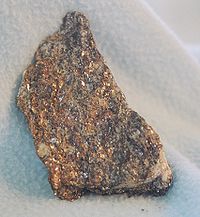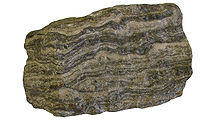what does heat and pressure cause rocks to do
In this lesson you lot volition acquire virtually metamorphic rocks, how they form, and some of their common uses. Figure 4.13 shows a large outcrop of metamorphic rocks. Notice the platy layers that run from left to right within the rock. It looks as though y'all could easily intermission off layers from the forepart surface of the outcrop. This layering is a result of the process of metamorphism. Metamorphism is the irresolute of rocks by heat and pressure. During this process, rocks change either physically and/or chemically. They alter and then much that they go an entirely new stone.

Effigy four.xiii: The platy layers in this big outcrop of metamorphic rock testify the effects of pressure on rocks during metamorphism.
Lesson Objectives
- Describe how metamorphic rocks are formed.
- Describe the properties of some common metamorphic rocks.
- Chronicle some mutual uses of metamorphic rocks.
Metamorphism
Metamorphic rocks start off as igneous, sedimentary, or other metamorphic rocks. These rocks are changed when estrus or pressure alters the existing stone'south physical or chemical make upward. 1 ways rocks may change during metamorphism is past rearrangement of their mineral crystals. When heat and pressure change the environment of a rock, the crystals may respond by rearranging their construction. They will form new minerals that are more thanstable in the new surround. Extreme pressure may also atomic number 82 to the formation offoliation, or apartment layers in rocks that form equally the rocks are squeezed by pressure. Foliation normally forms when pressure was exerted on a rock from one management. If pressure is exerted from all directions, then the rock usually does non evidence foliation.
There are two main types of metamorphism:
- Contact metamorphism—occurs when magma contacts a rock, changing it by extreme heat (Figure 4.xiv).
- Regional metamorphism—occurs when great masses of rock change over a broad area due to pressure exerted on rocks at plate boundaries.

Effigy iv.14: This diagram shows hot magma inside the earth contacting diverse rock layers. This is an example of contact metamorphism.
Information technology is important to annotation that metamorphism does non cause complete melting of the initial stone. It just causes changes to a rock by estrus or force per unit area. The rearrangement of the mineral crystals is the near common style that we detect these changes. Tabular array 4.3 shows some common metamorphic rocks and the original rocks that they come from.
| Picture | Rock Name | Blazon | Comments |
|---|---|---|---|
 | Slate | Foliated | Metamorphism of shale |
 | Phyllite | Foliated | Metamorphism of slate, but nether greater heat and pressure than slate |
 | Schist | Foliated | Often derived from metamorphism of claystone or shale; metamorphosed under more estrus and pressure than phyllite |
 | Gneiss | Foliated | Metamorphism of diverse different rocks, under farthermost conditions of heat and pressure level |
 | Hornfels | Non-foliated | Contact metamorphism of various different rock types |
 | Quartzite | Non-foliated | Metamorphism of sandstone |
 | Marble | Non-foliated | Metamorphism of limestone |

Figure four.15: Marble is used for decorative items and in art.
Hornfels, with its alternating bands of dark and light crystals is a skillful case of how minerals rearrange themselves during metamorphism. In this example, the minerals separated by density and became banded. Gneiss forms by regional metamorphism from both loftier temperature and pressure.
Quartzite and marble are the nigh commonly used metamorphic rocks. They are frequently chosen for building materials and artwork. Marble is used for statues and decorative items like vases (Figure four.15). Basis up marble is also a component of toothpaste, plastics, and paper. Quartzite is very hard and is often crushed and used in building railroad tracks (Figure iv.16). Schist and slate are sometimes used as edifice and mural materials.

Figure four.16: Crushed quartzite is sometimes placed under railroad tracks because it is very hard and durable.
Lesson Summary
- Metamorphic rocks form when heat and pressure transform an existing rock into a new rock.
- Contact metamorphism occurs when hot magma transforms rock that information technology contacts.
- Regional metamorphism transforms big areas of existing rocks under the tremendous estrus and pressure created by tectonic forces.
Review Questions
- Why exercise the minerals in a rock sometimes rearrange themselves when exposed to rut or force per unit area?
- What is foliation in metamorphic rocks?
- Describe the different conditions that pb to foliated versus non-foliated metamorphic rocks.
- List and describe the two master types of metamorphism.
- How can metamorphic rocks exist a clue to how they were formed?
- Suppose a phyllite sample was metamorphosed again. How might it look different after this 2d round of metamorphism.
Vocabulary
- contact metamorphism
- Results from temperature increases when a body of magma contacts a cooler existing stone.
- foliation
- Property of some metamorphic rocks in which flat layers are formed; seen as prove of squeezing by pressure.
- regional metamorphism
- Occurs when dandy masses of rock change over a wide area due to pressure.
- stable
- Steady and not probable to change significantly any more.
Points to Consider
- What type of plate boundary would produce the most intense metamorphism of rock?
- Do you think new minerals could form when an existing rock is metamorphosed?
valdiviayousigulas.blogspot.com
Source: https://courses.lumenlearning.com/earthscience/chapter/metamorphic-rocks/
0 Response to "what does heat and pressure cause rocks to do"
Post a Comment